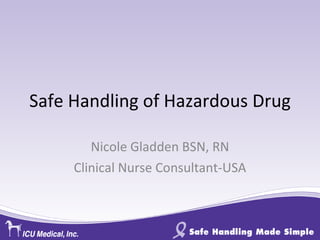Mn 510 power_point_week_5[2]
- 1. Safe Handling of Hazardous Drug Nicole Gladden BSN, RN Clinical Nurse Consultant-USA
- 2. The Problem Mixing, transporting, administering and disposing of chemotherapy drugs represents a safety hazard to pharmacists, nurses and patientsŌĆöand this risk is well documented.
- 3. Solutions The use of closed system transfer devices in conjunction with other safety precautions such as gloves, gowns, masks and vented preparation hoods presents a proven way to mitigate the risks. Please don your PPE
- 4. ChemoClave The ICU Medical ChemoCLAVE system is a mechanically and microbiologically closed needle-free system that provides a complete end-to-end solution from preparation through to disposal compatible with virtually all antineoplastic drugs given during chemotherapy treatments.
- 5. Preparation Vial Access Products One size fits all Fully draining Genie Vapor Capture
- 6. The Genie Click here for Pharmacy Video
- 7. Transport/Administration SPIROS Closed Male Luer MECHANICALLY AND MICROBIOLOGICALLY CLOSED USED ON END OF SYRINGE OR IV TUBING VALVE OPENS WHEN CONNECTED TO FEMALE LUER CLOSES ON DISCONNECT
- 8. The Spiros Click here for Nursing Video
- 9. References ICU Medical, Inc. (2011) Oncology preparation & delivery systems . Retrieved from http://icumed.com/oncology/index.asp#TechSpecs Jacobson, J. O., Polovich, M., McNiff, K. K., LeFebvre, K. B., Cummings, C., Galioto, M.,... McCorkle, M. R. (2009). American Society of Clinical Oncology/Oncology Nursing Society chemotherapy administration safety standards. Oncology Nursing Forum, 36 (6), 651-658. doi:10.1188/09.ONF.651-658 National Institute for Occupational Safety and Health (2004). Preventing occu┬Łpational exposure to antineoplastic and other hazardous drugs in health care settings . Retrieved from http://www.cdc.gov/niosh/docs/2010-167/pdfs/2010-167.pdf
Editor's Notes
- #3: This teaching/learning plan will be designed to explain the guidelines that have been established by the Oncology Nursing Society (ONS), the Occupational Safety and Health Administration (OSHA), and the American Society of Hospital Pharmacist (ASHP) for Registered Nurses (RNs) and Registered Pharmacists (RPh) who wish to implement the use of a closed system transfer device (CSTD) in a clinical setting(Jacobson et al., 2009).
- #4: The plan will be specific to the ChemoClave, defined by the ONS as a drug transfer device that mechanically prohibits the transfer of environmental contaminants into the system and the escape of hazardous drug or vapor concentrations outside the system (Jacobson et al., 2009). In addition to meeting NIOSH and ASHP guidelines, ChemoCLAVE is an intuitive, easy-to-useneedlefree system that is preferred by nurses, helping ensure compliance from beginning to end. >As a 100% needefree system, ChemoCLAVE eliminates the risk of hazardous needlesticksŌĆöcompeting systems have a needle shown to pose a potential hazard to clinicians. >Competing systems are cumbersome and require the assembly and disassembly of multiple complex parts in order to be effective. >Some hospitals that have implemented our competitorŌĆÖs system have had the nursing staff refuse to use it and switched to ChemoCLAVE for the transportation, administration and disposal. >Key Take-Away:ICU MedicalŌĆÖs ChemoCLAVE CSTD system is the best choice, providing me with a safe, simpleand secureway to enhance the safety of pharmacists, nurses and patients.
- #5: The ChemoClave meets The National Institute for Occupational Safety and Health (NIOSH)a guidelines, is an intuitive, easy-to-use needlefree system that is preferred by nurses, helping ensure compliance from beginning to end (NIOSH, 2004). >As a 100% needefree system, ChemoCLAVE eliminates the risk of hazardous needlesticksŌĆöcompeting systems have a needle shown to pose a potential hazard to clinicians. >Competing systems are cumbersome and require the assembly and disassembly of multiple complex parts in order to be effective. >Some hospitals that have implemented our competitorŌĆÖs system have had the nursing staff refuse to use it and switched to ChemoCLAVE for the transportation, administration and disposal. >Key Take-Away:ICU MedicalŌĆÖs ChemoCLAVE CSTD system is the best choice, providing me with a safe, simpleand secureway to enhance the safety of pharmacists, nurses and patients (ICU Medical, 2011).
- #6: Preparation: The Genie is a needle-free vial access device that decreases aerosolization, vapors or leaks that automatically equalizes vial pressure inside a vial (ICU Medical, 2011).
- #7: The Genie is a needle-free vial access device that decreases aerosolization, vapors or leaks that automatically equalizes vial pressure inside a vial, see video (ICU Medical, 2011)
- #8: The Spiros is a closed male luer connector that will remain permanently attached to any female luer device, prevents tubing or syringes from disconnect thus eliminating the risk of exposure to hazardous drugs, (ICU Medical, 2011).
- #9: The Spiros is a closed male luer connector that will remain permanently attached to any female luer device, prevents tubing or syringes from disconnect thus eliminating the risk of exposure to hazardous drugs, see video (ICU Medical, 2011).









